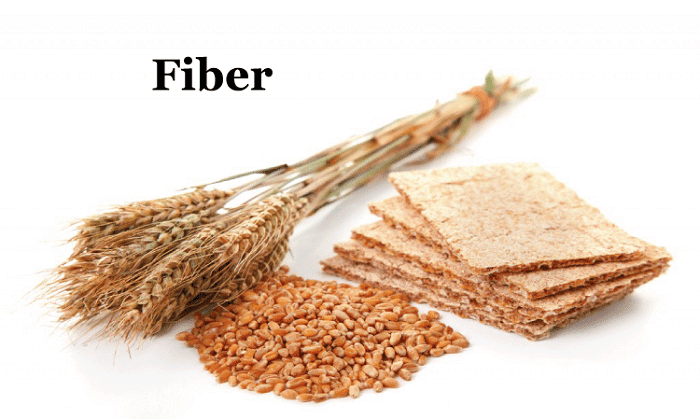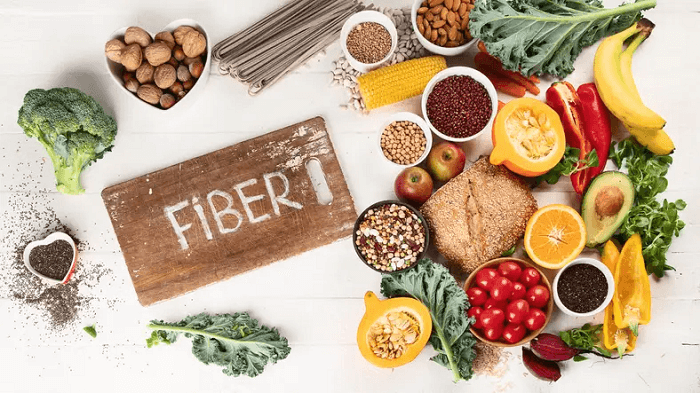Fiber DefinitionThe body cannot digest or absorb fiber, also known as dietary fiber, a carbohydrate type. Instead, it largely survives the digestive process and offers several health advantages. Many plant-based foods, such as fruits, vegetables, whole grains, beans, and legumes, include fiber. This post will examine the definition of fiber and its numerous health advantages. 
Fibre DefinitionA type of carbohydrate called fiber is present in foods made of plants. Unlike other carbohydrates like sugars and starches, the body's enzymes in the small intestine cannot digest fiber. Instead, it mostly remains intact as it moves through the digestive system. While fiber does not add to the body's calorie intake or supply energy, it offers many significant health advantages. Types of FiberThere are two mainly types of fiber 1. Soluble Fiber In the digestive system, soluble fiber transforms into a gel-like substance after dissolving in water. In contrast to insoluble fiber, soluble fiber breaks down in the stomach to form a thick, sticky substance that can slow the absorption of food and nutrients. Insoluble fiber does not dissolve in water and mostly remains intact during digestion. Soluble fiber has several advantages, one of which is that it can lower cholesterol levels by attaching to bile acids in the stomach and blocking their reabsorption. This makes the liver use more cholesterol to make more bile acids, which may eventually cause blood cholesterol levels to decrease. Moreover, studies have shown that soluble fiber helps lower blood sugar levels by delaying the bloodstream's absorption of sugar, which is particularly advantageous for those with diabetes or insulin resistance. Soluble fiber has numerous health benefits, including lowering cholesterol and controlling blood sugar. It can also enhance digestive health by encouraging the development of good gut bacteria. This can help prevent constipation and other digestive issues and positively impact immune function and overall health. Foods with soluble fiber include oats, beans, peas, fruits, and vegetables. Adding more of these foods to your diet can help increase your soluble fiber intake and reap the many health benefits it offers. Consuming at least 25 grams of fiber per day for women and 38 grams for men is recommended, with a good balance of soluble and insoluble fiber. 2. Insoluble Fiber Dietary fiber is known as insoluble fiber, which does not dissolve in water and gives the digestive tract bulk. Insoluble fiber stays mainly intact throughout digestion and aids in moving waste through the digestive tract, in contrast to soluble fiber, which transforms into a gel-like material in the stomach. The ability of insoluble fiber to lessen constipation and encourage regularity is one of its main advantages. This is so that the stool will be simpler to pass through the digestive system since insoluble fiber gives the stool more volume. Also, it can aid in the prevention of additional digestive problems like diverticulitis, hemorrhoids, and irritable bowel syndrome (IBS). Insoluble fiber may offer more health advantages than those beneficial to the digestive system. According to some research, a high-fiber diet that includes soluble and insoluble fiber may help reduce the risk of heart disease, stroke, and cancer. According to another study, an eating plan with fiber may help with weight reduction and control. Whole grains, nuts, and seeds, as well as several fruits and vegetables, are foods that are high in insoluble fiber. Excellent sources of insoluble fiber include whole wheat bread, brown rice, popcorn, and leafy green vegetables. You may boost your insoluble fiber intake and benefit from its numerous health advantages by including more of these items in your diet. While soluble and insoluble fiber benefits digestive health, they have different physiological purposes. Blood sugar levels are controlled, the growth of good gut flora is encouraged, and cholesterol levels are reduced with the aid of soluble fiber. In contrast, soluble fiber encourages regularity while also aiding in the prevention of constipation and maybe having additional health advantages. It's crucial to eat a balanced diet that features a range of fruits, vegetables, whole grains, nuts, and seeds to maximize the benefits of both forms of fiber. Women should consume 25 grams of fiber daily, while men should ingest 38 grams. However, most individuals do not get enough fiber in their diets. Health Benefits of FiberFiber provides a wide range of health benefits, including: 1. Promoting Digestive Health A carbohydrate known as fiber is one that the body cannot digest or absorb. Instead, it goes through the digestive system mostly undamaged, offering the body several advantages, particularly in maintaining excellent digestive health. By encouraging regularity and reducing constipation, fiber is one of the main ways it keeps the digestive system in good shape. Insoluble fiber gives stool volume, which makes it easier to pass through the digestive tract and lowers the risk of constipation. Furthermore, fiber absorbs water in the colon, softening and facilitating bowel movement. Together with encouraging regularity, fiber is essential for feeding the good bacteria in the stomach. These microorganisms are necessary for preserving a balanced gut microbiome, associated with several positive health effects, such as increased immune function, better mental health, and a lower chance of developing certain conditions, including diabetes, heart disease, and some malignancies. Prebiotic fibers like inulin, Fructooligosaccharides (FOS), and resistant starch help the good bacteria in the stomach grow. Several plant-based foods contain these fibers, such as fruits, vegetables, legumes, whole grains, and nuts. These fibers are digested by gut bacteria when they get to the colon, creating short-chain fatty acids (SCFAs). In addition to supplying energy to the colon's lining cells, SCFAs also contain anti-inflammatory properties that lower the likelihood of inflammatory bowel conditions, including Crohn's disease and ulcerative colitis. 2. Lowering Cholesterol Cholesterol is a fat essential for normal body function, but too much in the bloodstream can increase the risk of heart disease. Fortunately, there are several ways to lower cholesterol levels, one of which is through consuming soluble fiber. Soluble fiber is a dietary fiber that dissolves in water to form a gel-like substance in the digestive system. This substance can bind to cholesterol and other fats in the gut, preventing their absorption into the bloodstream. By doing so, soluble fiber can help lower cholesterol levels in the body, reducing the risk of heart disease. Studies have shown that consuming soluble fiber can reduce LDL cholesterol (the "bad" cholesterol) levels by an average of 5% to 10%. Soluble fiber can be found in various plant-based foods such as oats, barley, beans, lentils, fruits, and vegetables. One of the reasons soluble fiber effectively lowers cholesterol levels is that it promotes the growth of beneficial gut bacteria. These bacteria can ferment the soluble fiber, producing short-chain fatty acids (SCFAs), which can improve cholesterol metabolism and reduce the amount of cholesterol absorbed into the bloodstream. In addition to its cholesterol-lowering benefits, consuming soluble fiber can also help to promote regular bowel movements, reduce blood sugar levels, and improve overall digestive health. 3. Regulating Blood Sugar Soluble fiber is a dietary fiber that dissolves in water to form a gel-like substance in the digestive system. One of the benefits of consuming soluble fiber is its ability to regulate blood sugar levels, which is especially important for people with diabetes. When we eat carbohydrates, they are broken down into glucose and absorbed into the bloodstream. This can cause a spike in blood sugar levels, especially in people with diabetes who have impaired insulin function. Soluble fiber can help slow down the absorption of carbohydrates into the bloodstream, preventing these spikes in blood sugar levels. The gel-like substance formed by soluble fiber can slow down the digestive process, allowing carbohydrates to be released more slowly into the bloodstream. This can help to prevent rapid increases in blood sugar levels and can help to maintain more stable blood sugar levels over time. Studies have shown that consuming soluble fiber can improve blood sugar control in people with diabetes. In one study, participants with type 2 diabetes who consumed a high-fiber diet for six weeks experienced a significant decrease in their HbA1c levels, a measure of long-term blood sugar control. 4. Promoting Weight Loss Fiber is an important component of a healthy diet, and one of its benefits is its ability to promote feelings of fullness and satiety. High-fiber foods are often more filling than low-fiber foods, which can help to reduce overall calorie intake and promote weight loss. Fiber takes longer to digest than other nutrients like carbohydrates and fats. As a result, it can help slow down the digestive process and keep us feeling full for longer periods. This can be especially beneficial for people trying to lose weight, as it can help reduce overall calorie intake and prevent overeating. Studies have shown that consuming high-fiber foods can lead to weight loss and improvements in body composition. In one study, participants who consumed a high-fiber diet for six months experienced significant reductions in body weight, body mass index (BMI), and waist circumference. In addition to its weight loss benefits, consuming high-fiber foods can also help to improve overall digestive health, lower cholesterol levels, and reduce the risk of heart disease. Some examples of high-fiber foods include fruits, vegetables, whole grains, beans, nuts, and seeds. It is important to gradually increase fiber intake to avoid digestive discomfort and drink plenty of water to help fiber move through the digestive system. 5. Reducing the Risk of Heart Disease Heart disease is a leading cause of death worldwide, and its prevalence continues to increase. An unhealthy diet is one of the primary factors contributing to the development of heart disease. Research has shown that consuming a diet high in fiber can significantly reduce the risk of heart disease by improving several key markers of cardiovascular health. Firstly, a high-fiber diet can lower cholesterol levels. Cholesterol is a type of fat that can accumulate in the walls of arteries, leading to blockages that can increase the risk of heart disease. Soluble fiber found in foods such as oatmeal, beans, and fruits has been shown to reduce cholesterol levels by binding to cholesterol in the gut and preventing it from being absorbed into the bloodstream. In addition to lowering cholesterol levels, a high-fiber diet can help regulate blood sugar levels. Fibre slows the absorption of sugar in the bloodstream, preventing the rapid spikes and crashes that can occur with a diet high in refined carbohydrates. This can help prevent the development of type 2 diabetes, which is a significant risk factor for heart disease. Furthermore, a high-fiber diet can promote weight loss, another important factor in reducing the risk of heart disease. Foods high in fiber tend to be low in calories, making them an excellent choice for people trying to lose weight. Additionally, fiber helps you feel full, reducing the urge to overeat. Sources of FiberFibre is found in a variety of plant-based foods, including:
It's important to note that fiber is only found in plant-based foods. Animal products like meat, dairy, and eggs do not contain fiber. 
How Much Fiber Do We Need?The recommended daily fiber intake varies depending on age, sex, and other factors. In general, the daily recommended intake of fiber is:
Including adequate fiber in your diet can provide several health advantages. Regularity is encouraged, and constipation is avoided with the aid of fiber. Also, it aids in lowering cholesterol levels, bettering blood sugar regulation, and lowering the risk of diabetes, heart disease, and stroke. Fiber also keeps you full and pleased, promoting weight reduction and control. It's critical to remember that abruptly increasing your fiber intake might cause digestive discomforts, such as bloating, gas, and diarrhea. To help prevent these symptoms, gradually increase your fiber intake over several weeks and drink lots of water.
Next TopicFinancial Management Definition
|
 For Videos Join Our Youtube Channel: Join Now
For Videos Join Our Youtube Channel: Join Now
Feedback
- Send your Feedback to [email protected]
Help Others, Please Share










